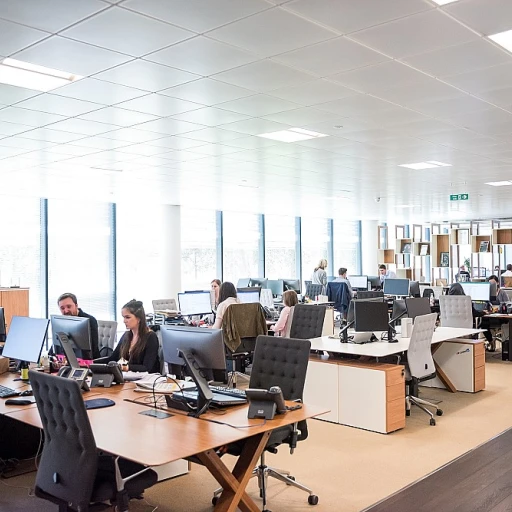
Understanding the Unique Needs of Indian Workspaces
Assessing the Unique Characteristics of Indian Workspaces
In the journey towards a successful office transformation, understanding the distinct needs of Indian workspaces is pivotal. The diverse cultural and regional variances present a complex canvas where one size does not fit all. Careful analysis is needed to tailor each office refurbishment project to its specific context. Indian companies often juggle between modern open-plan office layouts and more conservative designs influenced by traditional business practices. This dynamic aspect requires a balanced approach when designing office spaces. Firms should aim to create environments that foster collaboration without compromising on privacy. A significant point to consider is the increasing move towards incorporating natural light and ergonomic furniture into office design. This not only elevates employee well-being but also enhances productivity, a key aspect discussed further in the transformation process. In the planning phase, early consideration of these elements can guide office transformations by helping teams select the right design build partners and materials. This approach can effectively handle lead times and mitigate potential delays. Further details on optimizing project timelines can be found in enhancing efficiency. Additionally, it's essential to address fire safety, adherence to privacy policies, and compliance with local regulations from the very beginning, ensuring smooth project execution and alignment with legal requirements. Through thoughtful planning and understanding of these unique workspace requirements, the pathway to successful office transformation becomes clearer.Budgeting and Cost Management
Effective Budget Allocation for Office Transformation
When planning an office refurbishment, budgeting is a crucial aspect that can significantly impact the project's success. By understanding and managing costs effectively, your business can achieve a workspace transformation that not only meets your company's needs but also enhances employee well-being. Creating a budget requires careful consideration of various elements such as design, office space, furniture, and potential lead times. Here are some important factors to guide office planning:- Comprehensive Cost Analysis: Start with a thorough analysis of all potential expenses. This includes everything from interior design to office fit-outs and meeting spaces. A comprehensive cost breakdown will help avoid unexpected financial setbacks.
- Setting Priorities: Identify key areas within the office that require urgent attention. Be it an upgrade in ergonomic furniture or optimizing open plan areas to enhance natural light, prioritizing needs can streamline the allocation of resources efficiently.
- Identifying Hidden Costs: Often, there are hidden costs associated with office transformation projects, like compliance with fire safety regulations or updating the privacy policy infrastructure. Including these in the initial budget can help sidestep unforeseen financial strains.
- Partnering with the Right Professionals: Collaborating with an experienced build partner can make a significant difference. These experts can guide you through the refurbishment process, ensuring optimal use of the budget and timely project completion. It's worth exploring some top project managers for enhancing office spaces who can bring expertise and efficiency to your project.
- Consideration for Employee Well-being: A well-thought-out budget also considers the impact on employee well-being. Investing in creating comfortable work environments, such as incorporating natural light and well-designed ergonomic furniture, can lead to a more productive workforce.
Incorporating Sustainable Practices
Embracing Eco-Friendly Office Refurbishment
Incorporating sustainability into your office design is not just a trend, but a necessary transformation for Indian businesses aiming to reduce their carbon footprint. An eco-friendly office fit involves selecting sustainable materials and energy-efficient technologies that not only help the environment but also contribute positively to your business's bottom line.
Begin your project by consulting with a design-build partner who understands the importance of sustainability in office spaces. They'll guide you through choosing materials with low environmental impact, such as recycled wood or rapidly renewable resources. When it comes to lighting, opting for LED bulbs can drastically cut down energy consumption, ensuring you stick to your budget while embracing green practices.
Introducing natural light into your office space is another impactful change. Not only does it reduce reliance on artificial lighting, but it also boosts employee well-being and productivity. The abundant use of glass partitions and open-plan layouts can maximize natural light flow, creating a comfortable work environment.
Furthermore, consider the installation of ergonomic furniture crafted from sustainable sources. This move not only aligns with environmental goals but also ensures that your employees work in a healthy, supportive environment. Ergonomic design minimizes the risk of physical strain, thereby enhancing employee well-being.
Planning early in your office refurbishment journey to incorporate these sustainable practices is crucial. They can streamline the process and minimize disruptions. Be mindful of lead times when ordering materials and respect fire safety and privacy policies to ensure compliance with regulations.
Considering sustainability in legislation and user agreements related to office transformations can also prevent future legal headaches. Navigate these carefully with the help of your planning office team, and ensure that your refurbishment project aligns with the necessary compliance standards.
For more insights into managing costs effectively while upgrading your workspaces, have a look at financial accuracy in office refurbishment.
Enhancing Employee Well-being and Productivity
Fostering a Healthy and Productive Work Environment
When planning an office refurbishment, the well-being of employees should be a top priority. A well-designed workspace can significantly influence productivity, job satisfaction, and overall morale. Here are some key aspects to consider:
- Ergonomic Furniture: Investing in ergonomic furniture helps create comfortable workstations that prevent strain and injury. It's crucial to select chairs, desks, and accessories that support healthy posture for employees.
- Natural Light and Ventilation: Design the office space to maximize the use of natural light. This not only reduces energy costs but also enhances mood and productivity. Effective ventilation is equally important to maintain a fresh and healthy atmosphere.
- Open Plan vs. Privacy: While open plan offices can foster collaboration, it's essential to balance them with private meeting spaces where employees can focus without distractions.
- Breakout Areas: Designated areas for relaxation and informal meetings can greatly enhance the office environment. These spaces encourage creativity and foster a sense of community among team members.
By thoughtfully integrating these elements during the office refurbishment planning process, businesses can create a workspace that supports their team’s well-being and drives success.
Leveraging Technology for Modern Workspaces
Utilizing Advanced Technologies to Elevate Office Spaces
In the modern office environment, leveraging technology is crucial for an effective workspace transformation. Technology plays a significant role in enhancing the functionality and efficiency of the office space. Here's how you can incorporate technology into your refurbishment project:- Interactive Meeting Spaces: Integrate advanced audiovisual equipment to facilitate seamless communication during meetings. This not only aids in engaging presentations but also supports virtual meetings, accommodating remote work preferences.
- Smart Office Systems: Implement smart lighting, heating, and cooling systems to optimize energy use and enhance office well-being. Such systems can automatically adjust settings based on occupancy and natural light availability.
- Ergonomic Furniture: Choose furniture that supports employee well-being through ergonomic designs that promote good posture and comfort.
- Space Management Tools: Use technology solutions to plan and manage office design. Software tools can help visualize layouts and assess how different office arrangements impact workflow.
Navigating Regulatory and Compliance Challenges
Compliance and Regulatory Frameworks: A Crucial Aspect
Navigating the compliance and regulatory landscape is instrumental in the successful delivery of any office refurbishment project. Indian companies must consider various legal obligations and standards, which can significantly influence your office transformation.- Understanding Local Regulations: The design and construction of office spaces are governed by several legal requirements. These regulations can include fire safety, building codes, and accessibility standards. It's vital to integrate these elements from the start of your planning office process to avoid potential setbacks.
- Privacy Policies and User Agreements: Contemporary workspaces emphasize collaborative environments while ensuring privacy for employees. Having a clear privacy policy in place can help create a comfortable workspace and protect sensitive data.
- Collaboration with Build Partners: Employing experienced build partners familiar with the local landscape can be beneficial. They can guide your office fit project while ensuring compliance with the relevant laws, reducing lead times and meeting spaces' requirements efficiently.
- Safety and Health Considerations: Prioritizing employees' well-being by integrating natural light, ergonomic furniture, and ensuring proper ventilation is not only a part of sustainable practices but also a regulatory mandate. Indian workplaces that emphasize employee well-being see increased productivity and satisfaction.
- Company's Internal Policies: Every business has internal guidelines that must align with legal directives. Early planning can harmonize company norms with federal and state regulations, ensuring smooth operations.













